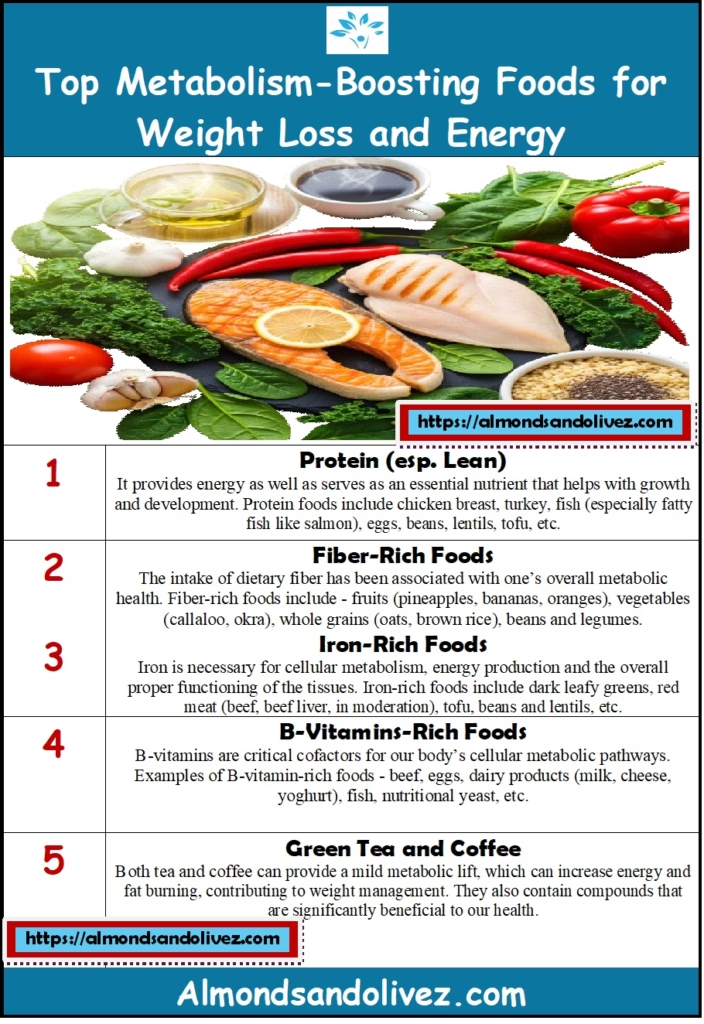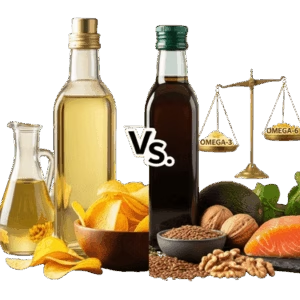TABLE OF CONTENTS
Do you ever feel like your energy levels are constantly dragging, even after a full night’s sleep? Or perhaps you’re diligently trying to lose weight, but the numbers on the scale just won’t budge? Often, the answer lies in understanding and supporting your metabolism – the intricate process by which your body converts food into energy.
While no single food is a “magic bullet,” certain foods can play a significant role in optimizing your metabolic rate, providing sustained energy, and supporting your weight management efforts. In this article, we will explore what metabolism is, what it truly means and some of the foods that can help stoke your internal fire. Let’s Discuss!
The Discussion
Before we jump into the foods, let’s briefly understand metabolism. Simply put, metabolism is how your body converts food into energy. Every living organism relies upon its environment to survive. This is done by taking what the environment provides for movement, growth and development for energy (Sánchez López de Nava A and Raja A, 2022).
As such, A healthy metabolism burns calories efficiently, providing you with consistent energy throughout the day and making it easier to manage your weight. Therefore, a healthy metabolism is key to sustained energy and maintaining a healthy weight. While factors like genetics play a role, the foods we eat can influence what is called the thermic effect of food (TEF), which is the calories your body burns digesting food, which further contributes to overall metabolic function.
The thermic effect of food (TEF) is also defined as the increase in the metabolic rate after you consume a meal (Calcagno M et al. 2019). While factors like genetics play a role, incorporating certain foods into your diet can create a thermic effect, meaning allowing your body to burn more calories after digesting them and thus contributing to overall metabolic function.
Further, reports suggest that the thermic effect of food (TEF) increases when you eat a larger meal, as opposed to frequent small meals (Calcagno M et al. 2019). Other factors that increase the thermic effect of food (TEF) include carbohydrates and proteins, as opposed to dietary fats and low-fat plant-based diets. Our age also plays a role in TEF, as well as how physically active we are (Calcagno M et al. 2019).
In this article, we will explore the top metabolism-boosting foods that have been proven by research that have the potential to increase metabolism. I will also provide some tips on how you can incorporate these foods into your lifestyle, as well as other ways in which you can optimize your metabolism.
You can read more about exercising, which can aid in increasing metabolism, as well as watch the video on foods that can boost your metabolism, by clicking the links below:
- Exercise, it is more than just for weight loss!
- Video – Top Metabolism – Boosting Foods for Weight Loss and Energy
Top Metabolism-Boosting Foods
- What is metabolism?
- Foods that can increase metabolism:
- Protein-rich foods
- Fiber-rich foods
- Iron-rich foods
- B-vitamin-rich foods
- Green Tea and Coffee
- Tips on how to incorporate these foods into your lifestyle.
Protein-Rich Foods and Metabolism
Protein is a major component of the human body. It provides energy as well as serves as an essential nutrient that helps with growth and development. The recommended daily allowance of protein is about 48-56 grams per day for adults, which is 0.80 g/kg of body weight (Fulgoni, 2008). This is the amount that is the amount of protein required to avoid deficiency. However, some people may opt to consume more depending on their lifestyle and degree of physical activity.
Protein has the highest Thermic Effect of Food (TEF) compared to fats and carbohydrates. This means your body expends more energy digesting protein. It also helps preserve and build lean muscle mass, which is metabolically active and burns more calories even at rest (Calcagno et al. 2019).
As it relates to weight loss and fatigue, the high TEF means more calories are burned. Protein also promotes satiety, reducing overall food intake. For fatigue, the amino acids in protein are crucial for repairing tissues and producing neurotransmitters, providing sustained energy and preventing crashes.
- Examples of protein-rich foods: Chicken breast, turkey, fish (especially fatty fish like salmon), eggs, beans, lentils, tofu, etc.
Fibre-Rich Foods and Metabolism
The intake of dietary fiber has been associated with one’s overall metabolic health. This is because adequate fiber can help to regulate appetite, metabolic processes, as well as chronic inflammation (Barber et al. 2020).
Fiber-rich foods, particularly soluble fiber, slow down digestion and the absorption of glucose, leading to a more gradual rise in blood sugar. This prevents insulin spikes that can lead to fat storage. It also supports a healthy gut microbiome, which is increasingly linked to metabolic health.
As it relates to weight loss and fatigue, a slower digestion means you feel fuller for longer, and satisfied, reducing snacking and aiding weight loss. The steady release of energy from complex carbs (found with fiber) prevents the “sugar crash” that often leads to fatigue as it releases sugar slowly into your bloodstream. A healthy gut also improves nutrient absorption for better energy.
To increase your fiber intake, think vibrant fruits and veggies, hearty whole grains and those amazing beans and lentils.
- Examples of fiber-rich foods: Fruits (mangoes, pineapples, bananas, oranges), vegetables (callaloo, okra, pumpkin), whole grains (oats, quinoa, brown rice), beans and legumes (gungo peas, red peas).
You can read more about fiber and its benefits in the articles below:
- Okra – It is all about the Fiber Plus four (4) other benefits you gotta know!
- The Otaheite (Jamaican) Apple – Full Guide to Benefits, Uses and Side Effects
Iron-Rich Foods and Metabolism
Iron, which is a trace mineral, is essential for overall health and well-being. We can get the necessary daily intake from dietary sources as well as supplements. Because our body cannot synthesize iron, we must ensure that we consume it daily (Coad and Pedley, 2014; Hunt et al., 2009).
Iron helps with the transportation of oxygen throughout the bloodstream via haemoglobin (Moustarah and Daley, 2024). As such, it is necessary for cellular metabolism, energy production and the overall proper functioning of the tissues (Moustarah and Daley, 2024).
Iron is also a cofactor for enzymes that contribute to energy metabolism and the overall functioning of the immune system (Moustarah F, Daley, 2024). As such, when our body is deficient, we will experience issues with our health, and that includes our metabolism. Hence, a feeling of fatigue and lack of energy.
- Examples of iron-rich foods: Red meat (beef, beef liver (organ meat), in moderation), beans (kidney beans, black beans), lentils, dark leafy greens (i.e. spinach and callaloo) and fortified cereals.
Adequate iron ensures your cells have the oxygen they need for optimal energy production, directly combating fatigue. By supporting energy levels, it also encourages physical activity, which aids in weight loss. If you’re low in iron, you might feel tired and sluggish, and your metabolism can suffer. Ensuring you’re getting enough iron is vital for both energy levels and supporting a healthy metabolic rate.
You can read more about iron and how it benefits, and foods it can be found in, in the article below, as well as a video:
- Ditch the Supplement – Here are Six (6) Iron-rich Foods to Add to Your Diet!
- Video – 3 ‘Must-Know’ Iron-Rich Foods for Nutrient Needs
B-Vitamins Rich Foods and Metabolism
B-Vitamins comprise a group of eight (8) water-soluble vitamins. These are – B1 (thiamine), B2 (riboflavin), B3 (niacin), B6 (Pyridoxine), B7 (biotin), B9 (folate/folic acid), and B12 (cobalamin/methylcobalamin). Our body does not store these vitamins; as such, we must get them from our diet or supplements daily.
These vitamins have two (2) main functions as they relate to our metabolism. The first is catabolic metabolism, which results in energy production and anabolic metabolism, which results in bioactive molecules (Hanna et al. 2022). Therefore, B-vitamins are critical cofactors for our body’s cellular metabolic pathways. To this extent, they are critical to our health and overall well-being.
For example, B-vitamins (like B12, folate, thiamine, riboflavin, niacin, and pantothenic acid) play a vital role in numerous metabolic processes, helping our body convert carbohydrates, fats, and proteins into energy. A deficiency in B-vitamins can hinder these processes. When we do not eat enough food with these vitamins or supplements, we can feel fatigue, lack of energy, which can greatly slow down our metabolism.
- Examples of B-vitamin-rich foods: B-12 is only found in animal products or fortified foods, such as beef, salmon, eggs, dairy products (milk, cheese, yoghurt), and fortified foods like nutritional yeast, cereals and plant-based milks.
You can read more about vitamins, including B-vitamins, in the article below. You can also watch a video about the key nutrients we need in our diet. Don’t forget to also download your free eBook on vitamins in general.
- Our ABCs – A Comprehensive Vitamins Overview
- Video – Key Nutrients to have in your diet
- eBook – Vitamins Guide
Green Tea and Coffee, and Metabolism
Green tea and coffee are two (2) of the world’s most widely consumed beverages or teas. This is due to the many benefits that both these teas contain. Both comprise compounds that have been touted to have numerous health benefits.
Chlorogenic acid (CGA) is one of the most bioactive compounds found in the green coffee bean. This compound has been denoted to exert anti-diabetic and anti-dyslipidemia function (Meng et al. 2013). It has also been shown to help modulate lipids and glucose metabolism. Coffee, primarily due to its caffeine content, can also temporarily boost metabolism and energy.
As per green tea, catechins (like Epigallocatechin gallate – EGCG) are a group of flavonoids found in green tea that have significant antioxidant properties. According to reports, these compounds may help to improve fat metabolism (American Heart Association Journals) as well as boost overall metabolism by increasing calorie burn. It may also help with energy expenditure. When combined with exercise, both green tea and coffee can enhance fat burning.
Further, due to their many powerful compounds, both green tea and coffee have been shown to have a modest thermogenic effect and may improve fat oxidation. Caffeine can also enhance alertness and potentially increase physical activity.
As such, both tea and coffee can provide a mild metabolic lift and increase fat burning, contributing to weight management. The caffeine offers a direct energy boost to combat fatigue, improving focus and readiness for activity. (Consume caffeine in moderation to avoid jitters or sleep disruption) (Lukitasari et al. 2020).
You can read more about the benefits of teas (including green tea) and coffee in the articles below. You can also watch a very informative video on Coffee via the link below.
- It’s teatime – Here are four (4) ‘to know’ benefits of teas, including weight loss and bone health.
- Is Coffee Good for You? Here are Five (5) Health Benefits Plus Some Cautionary Tales!
- Video – Let’s Talk Coffee!
How to Incorporate These Foods Into Your Lifestyle?
- Don’t rely on one magic food: A balanced diet rich in whole, unprocessed foods is key.
- Start your day with protein: Include eggs, Greek yoghurt, or a protein smoothie for breakfast.
- Add spices to your cooking: Experiment with chilli peppers, ginger, and other metabolism-boosting spices.
- Stay hydrated throughout the day: Keep a water bottle handy.
- Enjoy green tea or black coffee in moderation.
- Include lean protein with every meal.
- Don’t drastically cut calories: Severely restricting calories can actually slow down your metabolism in the long run.
- Pair with activity: Combine a metabolism-boosting diet with regular exercise to maximize results.
Illustrative Summary
Here is an illustrative summary of the TOP METABOLISM-BOOSTING FOODS for Weight Loss and Energy!
Let’s Sum Up!
While no single food will magically transform your metabolism overnight, incorporating these metabolism-boosting foods into a balanced and active lifestyle can be a powerful tool to fuel your energy levels and support your weight management goals. Embrace the delicious and nutritious options available to you and take a step towards a healthier and more energetic you!
So, now that we have explored some of the top foods for boosting metabolism, are you already adding these foods to your diet? If so, in what way? Also, if not, will you be ensuring to add them to your diet? Share it nuh!
You can read more about vitamins, minerals, iron and fiber in the articles below: You can also learn more about exercising and how to create your own fitness plan, as well as watch the video on the Top Metabolism-Boosting Foods below:
- Barber TM, Kabisch S, Pfeiffer AFH, Weickert MO. The Health Benefits of Dietary Fibre. Nutrients. 2020 Oct 21;12(10):3209. doi: 10.3390/nu12103209. PMID: 33096647; PMCID: PMC7589116.
- Calcagno M, Kahleova H, Alwarith J, Burgess NN, Flores RA, Busta ML, Barnard ND. The Thermic Effect of Food: A Review. J Am Coll Nutr. 2019 Aug;38(6):547-551. doi: 10.1080/07315724.2018.1552544. Epub 2019 Apr 25. PMID: 31021710.
- Coad J, Pedley K. Iron deficiency and iron deficiency anemia in women. Scand J Clin Lab Invest Suppl. 2014;244:82-9; discussion 89. [PubMed].
- Hanna M, Jaqua E, Nguyen V, Clay J. B Vitamins: Functions and Uses in Medicine. Perm J. 2022 Jun 29;26(2):89-97. doi: 10.7812/TPP/21.204. Epub 2022 Jun 17. PMID: 35933667; PMCID: PMC9662251.
- Hunt JR, Zito CA, Johnson LK. Body iron excretion by healthy men and women. Am J Clin Nutr. 2009 Jun;89(6):1792-8.
- Fulgoni VL., 3rd Current protein intake in America: analysis of the National Health and Nutrition Examination Survey, 20032004. Am J Clin Nutr. 2008;87:1554S–1557S. doi: 10.1093/ajcn/87.5.1554S. [DOI] [PubMed]
- Lukitasari M, Nugroho DA, Rohman MS, Widodo N, Farmawati A, Hastuti P. Beneficial effects of green coffee and green tea extract combination on metabolic syndrome improvement by affecting AMPK and PPAR-α gene expression. J Adv Pharm Technol Res. 2020 Apr-Jun;11(2):81-85. doi: 10.4103/japtr.JAPTR_116_19. Epub 2020 Apr 22. PMID: 32587821; PMCID: PMC7305783.
- Meng S, Cao J, Feng Q, Peng J, Hu Y. Roles of chlorogenic acid on regulating glucose and lipids metabolism: A review. Evid Based Complement Alternat Med 2013; 2013:801457.
- Moustarah F, Daley SF. Dietary Iron. [Updated 2024 Jan 8]. In: StatPearls [Internet]. Treasure Island (FL): StatPearls Publishing; 2025 Jan-. Available from: https://www.ncbi.nlm.nih.gov/books/NBK540969/
- Sánchez López de Nava A, Raja A. Physiology, Metabolism. [Updated 2022 Sep 12]. In: StatPearls [Internet]. Treasure Island (FL): StatPearls Publishing; 2025 Jan-. Available from: https://www.ncbi.nlm.nih.gov/books/NBK546690





